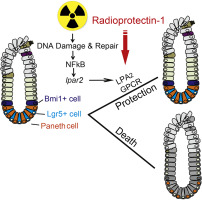Cellular Signalling ( IF 4.4 ) Pub Date : 2018-07-29 , DOI: 10.1016/j.cellsig.2018.07.007 Bryan Kuo 1 , Erzsébet Szabó 2 , Sue Chin Lee 2 , Andrea Balogh 2 , Derek Norman 1 , Asuka Inoue 3 , Yuki Ono 3 , Junken Aoki 3 , Gábor Tigyi 1

|
Rapidly proliferating cells are highly sensitive to ionizing radiation and can undergo apoptosis if the oxidative and genotoxic injury exceed the defensive and regenerative capacity of the cell. Our earlier work has established the antiapoptotic action of the growth factor-like lipid mediator lysophosphatidic acid (LPA). Activation of the LPA2 GPCR has been hypothesized to elicit antiapoptotic and regenerative actions of LPA. Based on this hypothesis we developed a novel nonlipid agonist of LPA2, which we designated Radioprotectin-1 (RP-1). We tested RP-1 at the six murine LPA GPCR subtypes using the transforming growth factor alpha shedding assay and found that it had a 25 nM EC50 that is similar to that of LPA18:1 at 32 nM. RP-1 effectively reduced apoptosis induced by γ-irradiation and the radiomimetic drug Adriamycin only in cells that expressed LPA2 either endogenously or after transfection. RP-1 reduced γ-H2AX levels in irradiated mouse embryonic fibroblasts transduced with the human LPA2 GPCR but was ineffective in vector transduced MEF control cells and significantly increased clonogenic survival after γ-irradiation. γ-Irradiation induced the expression of lpar2 transcripts that was further enhanced by RP-1 exposure within 30 min after irradiation. RP-1 decreased the mortality of C57BL/6 mice in models of the hematopoietic and gastrointestinal acute radiation syndromes. Using Lgr5-EGFP-CreER;Tdtomatoflox transgenic mice, we found that RP-1 increased the survival and growth of intestinal enteroids via the enhanced survival of Lgr5+ intestinal stem cells. Taken together, our results suggest that the LPA2-specific agonist RP-1 exerts its radioprotective and radiomitigative action through specific activation of the upregulated LPA2 GPCR in Lgr5+ stem cells.
中文翻译:

LPA2受体激动剂Radioprotectin-1使Lgr5阳性肠干细胞免于鼠类小肠的放射损伤。
快速增殖的细胞对电离辐射高度敏感,如果氧化和遗传毒性损伤超过细胞的防御和再生能力,则细胞会发生凋亡。我们的早期工作已经建立了生长因子样脂质介导的溶血磷脂酸(LPA)的抗凋亡作用。已经假设LPA 2 GPCR的激活可引起LPA的抗凋亡和再生作用。基于此假设,我们开发了一种新型的LPA 2非脂质激动剂,我们将其命名为Radioprotectin-1(RP-1)。我们使用转化生长因子α脱落测定法在6种鼠类LPA GPCR亚型上测试了RP-1,发现它具有25 nM EC 50与32 nM下的LPA18:1相似。RP-1仅在内源性或转染后表达LPA 2的细胞中有效降低了由γ射线和放射模拟药物阿霉素诱导的凋亡。RP-1降低了通过人LPA 2 GPCR转导的辐照小鼠胚胎成纤维细胞中γ-H2AX的水平,但在载体转导的MEF对照细胞中无效,并且显着提高了γ辐照后的克隆形成存活率。γ辐照诱导了lpar2转录本的表达,该辐照在辐照后30分钟内被RP-1暴露进一步增强。RP-1降低了造血和胃肠道急性放射综合症模型中C57BL / 6小鼠的死亡率。使用Lgr5-EGFP-CreER; Tdtomato亚麻转基因小鼠中,我们发现RP-1通过提高Lgr5 +肠干细胞的存活率来增加肠小肠的存活和生长。两者合计,我们的结果表明,LPA 2特异性激动剂RP-1通过特异性激活Lgr5 +干细胞中上调的LPA 2 GPCR发挥其辐射防护和放射缓解作用。











































 京公网安备 11010802027423号
京公网安备 11010802027423号